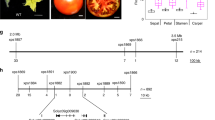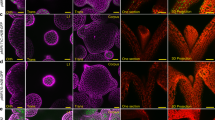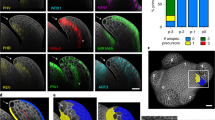Abstract
Meristem function in plants requires both the maintenance of stem cells and the specification of founder cells from which lateral organs arise. Lateral organs are patterned along proximodistal, dorsoventral and mediolateral axes1,2. Here we show that the Arabidopsis mutant asymmetric leaves1 (as1) disrupts this process. AS1 encodes a myb domain protein, closely related to PHANTASTICA in Antirrhinum and ROUGH SHEATH2 in maize, both of which negatively regulate knotted-class homeobox genes. AS1 negatively regulates the homeobox genes KNAT1 and KNAT2 and is, in turn, negatively regulated by the meristematic homeobox gene SHOOT MERISTEMLESS. This genetic pathway defines a mechanism for differentiating between stem cells and organ founder cells within the shoot apical meristem and demonstrates that genes expressed in organ primordia interact with meristematic genes to regulate shoot morphogenesis.
This is a preview of subscription content, access via your institution
Access options
Subscribe to this journal
Receive 51 print issues and online access
$199.00 per year
only $3.90 per issue
Buy this article
- Purchase on Springer Link
- Instant access to full article PDF
Prices may be subject to local taxes which are calculated during checkout




Similar content being viewed by others
References
Martienssen, R. & Dolan, L. in Arabidopsis. Annual Plant Reviews (eds Anderson, M. & Roberts, J.) 262– 297 (Sheffield Academic Press, Sheffield, 1998).
Hudson, A. Development of symmetry in plants. Annu. Rev. Plant. Physiol. Mol. Biol. 51, 349–370 ( 2000).
Jackson, D., Veit, B. & Hake, S. Expression of maize KNOTTED1 related homeobox genes in the shoot apical meristem predicts patterns of morphogenesis in the vegetative shoot. Development 120, 405–413 (1994).
Barton, M. K. & Poethig, R. S. Formation of the shoot apical meristem in Arabidopsis thaliana—an analysis of development in the wild type and in the shoot meristemless mutant. Development 119, 823–831 ( 1993).
Clark, S. E., Jacobsen, S. E., Levin, J. Z. & Meyerowitz, E. M. The CLAVATA and SHOOT MERISTEMLESS loci competitively regulate meristem activity in Arabidopsis. Development 122, 1567–1575 (1996).
Vollbrecht, E., Reiser, L. & Hake, S. Shoot meristem size is dependent on inbred background and presence of the maize homeobox gene, knotted1. Development 127, 3161–3172 ( 2000).
Reiser, L., Sanchez-Baracaldo, P. & Hake, S. Knots in the family tree: evolutionary relationships and functions of knox homeobox genes. Plant Mol. Biol. 42, 151–166 (2000).
Sinha, N. R., Williams, R. E. & Hake, S. Overexpression of the maize homeo box gene, KNOTTED-1 , causes a switch from determinate to indeterminate cell fates. Genes Dev. 7, 787–795 ( 1993).
Chuck, G., Lincoln, C. & Hake, S. Knat1 induces lobed leaves with ectopic meristems when overexpressed in Arabidopsis. Plant Cell 8, 1277–1289 (1996).
Waites, R., Selvadurai, H. R., Oliver, I. R. & Hudson, A. The PHANTASTICA gene encodes a MYB transcription factor involved in growth and dorsoventrality of lateral organs in Antirrhinum. Cell 93, 779–789 ( 1998).
Timmermans, M. C., Hudson, A., Becraft, P. W. & Nelson, T. ROUGH SHEATH2: a Myb protein that represses knox homeobox genes in maize lateral organ primordia. Science 284, 151–153 (1999).
Waites, R. & Hudson, A. phantastica: a gene required for dorsoventrality of leaves in Antirrhinum majus. Development 121, 2143–2154 ( 1995).
Tsiantis, M., Schneeberger, R., Golz, J. F., Freeling, M. & Langdale, J. A. The maize rough sheath2 gene and leaf development programs in monocot and dicot plants. Science 284, 154–156 ( 1999).
Schneeberger, R., Tsiantis, M., Freeling, M. & Langdale, J. A. The rough sheath2 gene negatively regulates homeobox gene expression during maize leaf development. Development 125, 2857–2865 (1998).
Reidei, G. P. Non-mendelian megagametogenesis in Arabidopsis. Genetics 51, 857–872 ( 1965).
Reinholz, E. Arabidopsis thaliana (L.) HEYNH. als Objekt fur genetische und entwicklungsphysiologische Untersuchungen. Arabidopsis Inform. Service 01S, 24 (1965).
Long, J. A., Moan, E. I., Medford, J. I. & Barton, M. K. A member of the KNOTTED class of homeodomain proteins encoded by the STM gene of Arabidopsis. Nature 379, 66–69 (1996).
Lincoln, C., Long, J., Yamaguchi, J., Serikawa, K. & Hake, S. A knotted1-like homeobox gene in Arabidopsis is expressed in the vegetative meristem and dramatically alters leaf morphology when overexpressed in transgenic plants. Plant Cell 6, 1859–1876 ( 1994).
Dockx, J. et al. The homeobox gene ATK1 of Arabidopsis thaliana is expressed in the shoot apex of the seedling and in flowers and inflorescence stems of mature plants. Plant Mol. Biol. 28, 723–737 (1995).
Lin, X. et al. Sequence and analysis of chromosome 2 of the plant Arabidopsis thaliana. Nature 402, 761– 768 (1999).
Long, J. & Barton, M. K. Initiation of axillary and floral meristems in Arabidopsis. Dev. Biol. 218, 341–353 (2000).
Endrizzi, K., Moussian, B., Haecker, A., Levin, J. Z. & Laux, T. The SHOOT MERISTEMLESS gene is required for maintenance of undifferentiated cells in Arabidopsis shoot and floral meristems and acts at a different regulatory level than the meristem genes WUSCHEL and ZWILLE. Plant J. 10, 101–113 (1996).
Clark, S. E., Running, M. P. & Meyerowitz, E. M. CLAVATA3 is a specific regulator of shoot and floral meristem development affecting the same processes as CLAVATA1 . Development 121, 2057– 2067 (1995).
Mayer, K. F. et al. Role of WUSCHEL in regulating stem cell fate in the Arabidopsis shoot meristem. Cell 95, 805–815 (1998).
Aida, M., Ishida, T. & Tasaka, M. Shoot apical meristem and cotyledon formation during Arabidopsis embryogenesis: interaction among the CUP-SHAPED COTYLEDON and SHOOT MERISTEMLESS genes. Development 126, 1563–1570 (1999).
Sundaresan, V. et al. Patterns of gene action in plant development revealed by enhancer trap and gene trap transposable elements. Gene Dev. 9, 1797–1810 (1995).
Li, J., Nagpal, P., Vitart, V., McMorris, T. C. & Chory, J. A role for brassinosteroids in light-dependent development of Arabidopsis. Science 272, 398– 401 (1996).
Springer, P. S., McCombie, W. R., Sundaresan, V. & Martienssen, R. A. Gene trap tagging of PROLIFERA, an essential MCM2-3-5-like gene in Arabidopsis. Science 268, 877– 880 (1995).
Hajdukiewicz, P., Svab, Z. & Maliga, P. The small, versatile pPZP family of Agrobacterium binary vectors for plant transformation. Plant Mol. Biol. 25, 989–994 (1994).
Liu, Y. G., Mitsukawa, N., Oosumi, T. & Whittier, R. F. Efficient isolation and mapping of Arabidopsis thaliana T-DNA insert junctions by thermal asymmetric interlaced PCR. Plant J. 8, 457–463 (1995).
Acknowledgements
We thank A. Groover, C. Kidner, E. Vollbrecht, M. Timmermans, J. Golz and D. Jackson for helpful discussions, Q. Gu, P. Springer, J. Li and J. Chory for help with mapping and T. Laux for wus-1 seed. We also thank T. Mulligan for plant care, and K. Schutz and D. McCombie for help with sequencing. This work was supported by a Human Frontiers Science Program postdoctoral fellowship to M.C., a Biotechnology and Biological Sciences Research Council studentship to R.B. and grant support from the National Science Foundation, Department of Energy and United States Department of Agriculture to R.M.
Author information
Authors and Affiliations
Corresponding author
Rights and permissions
About this article
Cite this article
Byrne, M., Barley, R., Curtis, M. et al. Asymmetric leaves1 mediates leaf patterning and stem cell function in Arabidopsis. Nature 408, 967–971 (2000). https://doi.org/10.1038/35050091
Received:
Accepted:
Issue Date:
DOI: https://doi.org/10.1038/35050091
This article is cited by
-
Transcriptome profiling at the transition to the reproductive stage uncovers stage and tissue-specific genes in wheat
BMC Plant Biology (2023)
-
Arabidopsis histone H3 lysine 9 methyltransferases KYP/SUVH5/6 are involved in leaf development by interacting with AS1-AS2 to repress KNAT1 and KNAT2
Communications Biology (2023)
-
Integrating ATAC-seq and RNA-seq to identify differentially expressed genes with chromatin-accessible changes during photosynthetic establishment in Populus leaves
Plant Molecular Biology (2023)
-
Dissected Leaf 1 encodes an MYB transcription factor that controls leaf morphology in potato
Theoretical and Applied Genetics (2023)
-
Biological Function and Stress Response Mechanism of MYB Transcription Factor Family Genes
Journal of Plant Growth Regulation (2023)
Comments
By submitting a comment you agree to abide by our Terms and Community Guidelines. If you find something abusive or that does not comply with our terms or guidelines please flag it as inappropriate.



